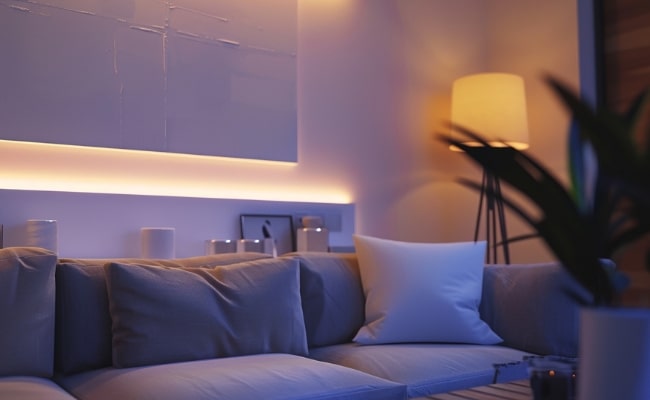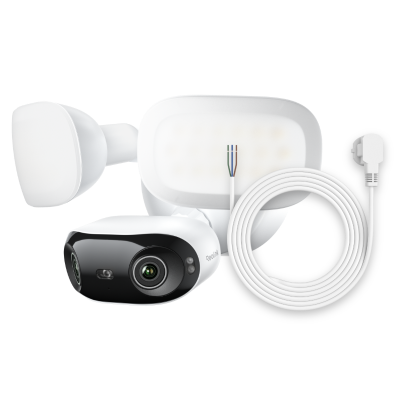Soft White vs Warm White: Which Light Bulb is Best for You?

Choosing the right lighting for your home can be tricky, especially when deciding between soft white vs warm white bulbs. Both options create a cozy ambiance, but they differ in color temperature, brightness, and the mood they set in each room. In this guide, we’ll break down the differences, explain the best uses for each type of light, and help you pick the perfect tone for your living spaces.
- Soft White vs. Warm White Bulbs: Brief Overview
- Soft White vs. Warm White: What's the Difference?
- Comparison Table between Soft and Warm White
- Warm White vs. Soft White: Where to Use
- Warm vs. Soft White: How to Choose between Them?
- Warm White vs. Soft White Lights: Which is Better for Security Cameras?
- FAQs
- Conclusion
Soft White vs. Warm White Bulbs: Brief Overview
Soft white light bulbs vs warm white are both general-purpose lighting options, suitable for a variety of applications. Soft white vs warm white light bulbs differ mainly in terms of light color, brightness, ambiance, energy efficiency, and available LED options.
What is a soft white light bulb?
A soft white bulb produces a warm, but bright, neutral light. The light is also warmer which makes for a more traditional and homelike environment. These types of bulbs are also useful for the bathroom, as well as for bedroom, living room, and hallway lighting.
What is a warm white light bulb?
Warm white bulbs generate a reddish-yellow halo that is warmer (lower color temperature) compared to soft white light bulbs. They provide decorative and intimate lighting which is suitable for any place where mood makes a difference such as dining rooms and restaurants.
Soft White vs. Warm White: What's the Difference?
Although both soft white vs warm white bulbs are technically considered general-purpose lighting, the key difference lies in their color temperature, measured in Kelvin, and the way they influence the atmosphere of a room. Soft white bulbs emit a warmer, more yellow glow (around 2700K–3000K), creating a cozy, relaxing, and intimate mood. In contrast, warm white bulbs are slightly brighter with a less yellow tone (around 3000K–3500K), producing a cheerful, inviting, and energetic ambiance.
Color Temperature
Color temperature describes the warmth or coolness of the light. Soft white bulbs are approximately 3000K and warm white bulbs approximate 2700K; warm white light bulbs have a lower color temperature, producing a warmer and more intimate yellow lighting.
As a comparison of available light, old-style light bulbs are typically 2700K this is lower on the scale of brightness and is warmer. Natural daylight is cooler, typically around 5000K to 6500K.
Brightness
Overall, soft white bulbs produce brighter (lumens) light energy at lower wattages than comparable warm white bulbs. For instance, a regular 60W soft white bulb has an output of around 800 lumens. Almost 750 m of lumens is the glow of a 60W warm white lamp, 60 W warm white lamp is really too weak.
So, if you need to brightly light a workspace, soft white is better. In terms of ambiance and less concerned about brightness level, warm white works well.
Ambiance
Since soft white LED bulbs emit crisp, bright light, they create an invigorating vibe perfect for working, reading, or concentrating. The sharp cool light keeps you focused.
Warm white glows with a yellowish tint reminiscent of old fashioned Edison-style bulbs. This makes them ideal for relaxing environments where ambiance trumps task lighting. Think cozy living rooms, dining spaces and bedrooms.
Energy Efficiency
Given the above notes on brightness, it follows that at equal wattage, soft white light bulbs tend to be slightly more energy efficient than comparable warm white bulbs. The extra luminosity comes from more lumens per watt. However, most modern bulbs have to meet federal minimum efficiency standards. So the exact technology behind the bulb makes a bigger difference.
This brings us to the fact that LED bulbs are available in both soft white and warm white. Since LEDs use a fraction of the energy of incandescents, they make the most eco-friendly choice by far. We’ll compare LED vs. other options later on.
LED Options
LED light bulbs are available in both soft white and warm white. Since LED bulbs last much longer and use less energy, they make a smart choice over traditional incandescent options. Just note that LED soft/warm white bulbs come in a range of color temperatures and brightnesses.
Comparison Table between Soft and Warm White
For a quick visualization, check out the comparison table below:
Warm White vs. Soft White: Where to Use
The soft white vs warm white light bulbs can be used across multiple settings like offices, living rooms, kitchens, etc. However, the best use of these bulbs is based on the place. Here are some guidelines on the best applications for soft white light bulbs vs warm white bulbs:
Where to use warm white light bulbs
Warm white light enhances the coziness and ambiance which is why they work well in the above rooms. The inviting glow encourages relaxation.
- Living rooms
- Bedrooms
- Dining rooms
- Restaurants
- Entryways
- SPA and wellness areas
Where to use soft white light bulbs
Soft white bulbs are a better match for work areas or rooms where bright, neutral light is preferred. The whiter tone has an energizing effect suited for tasks and chores.
- Offices
- Laundry rooms
- Kitchens
- Bathrooms
- Workshops & garages
- Hallways & staircases
Warm vs. Soft White: How to Choose between Them?
Here are some tips on deciding between warm white vs soft white bulbs:
- Consider the primary use of the room. Soft white works well for kitchens, bathrooms, and work areas that need lots of light. A warm white ambiance is preferred for cozy spaces like dining rooms.
- Take color temperature into account. Warm white 2700K bulbs provide a cozier effect. Soft white 3000K bulbs give brighter, cooler light.
- Think about room size. For large open concept rooms, soft white throws light further reducing shadows. For contained smaller rooms, warm white adds ambiance.
- Combine warm & soft white. Use warm white for main ceiling lights to create ambiance. Add soft white task lighting as needed.
- Evaluate personal preference. Do you prefer relaxing vs. energizing effects? Cooler vs. warmer tones? This helps determine personal tastes.
- Assess LED options if upgrading from traditional bulbs. Both warm white and soft white LED lights are available to save energy.
Warm White vs. Soft White Lights: Which is Better for Security Cameras?
When installing security cameras, warm white floodlight bulbs are the better option to provide more natural light. Soft white bulbs tend to produce glare and overexposure issues on cameras. The crisper cool light blows out images. Warm white 3000K floodlights enhance color accuracy and contrast optimizing surveillance footage. Some Reolink floodlight cameras come with adjustable lighting, so you can easily choose the color temperature that suits your needs.
4K 180° Ultra-Wide Wired Floodlight Security Camera
3000-Lumen Dimmable Lighting, Adjustable Color Temperature, Local AI Video Search, Local Storage, Dual-Band Wi-Fi 6.
FAQs
Is soft white or warm white better?
It depends on the room and the mood you want. Soft white (2700K–3000K) creates a warmer, cozier, and relaxing atmosphere, ideal for bedrooms and living rooms. Warm White (3000K–3500K) is slightly brighter and more energetic, great for kitchens, bathrooms, and workspaces.
Is soft white or warm white better for dining rooms?
Soft white (2700K–3000K) is better for dining rooms. Its warm, yellowish glow creates a cozy and inviting atmosphere, perfect for meals and social gatherings. Warm white (3000K–3500K) can work if you want a slightly brighter, more energetic ambiance, but soft white is preferred for a relaxing dining experience.
Is soft light the same as warm?
Not exactly. Soft light refers to the quality of the light, meaning it’s diffused and gentle, reducing harsh shadows. Warm light refers to the color temperature (usually 2700K–3500K), giving a yellowish, cozy glow. A bulb can be both soft and warm — soft describes how the light spreads, warm describes the color tone.
How to tell if a bulb is soft white?
You can identify a soft white bulb by checking:
- Color Temperature: Look for 2700K–3000K on the packaging — this range indicates soft white.
- Labeling: Many bulbs are explicitly marked “Soft White” on the box.
- Light Appearance: When turned on, soft white emits a warm, yellowish glow that’s cozy and relaxing, unlike cooler or bright white bulbs.
Conclusion
If you’re shopping for light bulbs, determine whether warm white vs soft white bulbs are right for your space. It may depend on how you’ll use the room, the mood you’re looking to create, color temperature preferences, and brightness needs. Warm white lighting creates a cozy atmosphere suitable for unwinding. Soft white bulbs eliminate that and illuminate a brighter, more neutral light suited to tasks.
Explore your lighting goals room by room to choose the soft white or warm white bulbs to meet your needs. Each gets their job done and it’s really just a matter of finding the right bulbs for the areas you want to light up.
Search
Subscribe for the Latest Updates
Security insights & offers right into your inbox

